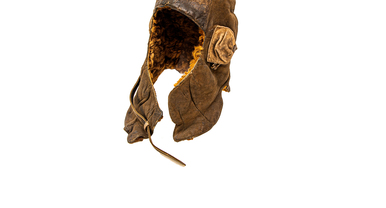Light and small plywood suitcases were typical items of the Great Patriotic War: the Red Army soldiers returned with them from the front. The front-line soldiers had very few personal belongings, and all of them could be crammed into the suitcase.
This exhibit from the museum’s collection belonged to Antonina Tipanova, an inhabitant of Kolomna. She brought it with her from her working watch. This suitcase was donated to the museum by her sister Yulia Zhagara in 2016, she also shared her family history with the museum.
In 1941, Antonina Tipanova turned 18. During wartime, she worked as a driver at the Malinsky airfield and transported bombs and bodies of dead pilots. From the stories of her elder sister, Yulia Zhagara knew that 2,000 prisoners built the airfield runway in just three days. After the war, Tipanova worked for a logistic and transport service (avtokolonna).
The life of the Tipanovs was closely tied with Kolomna. In the 1860s, during the construction of the Kolomensky Zavod, the sisters' grandparents moved to Kolomna from Ryazan governorate. The family took up residence near the plant in the village of Parfentievo.
Ivan Tipanov, Antonina’s and Yulia’s father was called to service in the tsarist army in 1914. He graduated from the Mining School for lower rank soldiers of His Imperial Majesty in Kronstadt. During the First World War, he served as a mine specialist at the main naval base of the Baltic Fleet. As the war ended, Tipanov returned to Kolomna and worked at the diesel workshop of the Kolomensky Zavod. During the Great Patriotic War, he had an exemption from military service as he was a highly-skilled specialist.
Tipanov’s sons Mikhail and Stanislav grew up and finished school. Mikhail Tipanov fought in the war, and after the war ended, he got a job at the Kolomensky Zavod modeling shop. Alexander Tipanov, a relative of the family, also took part in the Great Patriotic War. He was a machine gunner. In the battle of 1944, not far from Krasnoye Selo (now Krasnoselsky district of St. Petersburg), during the lifting of the Leningrad Siege, he covered an enemy pillbox with his body, thus he ensured that his comrades could advance further. For this act of bravery, he was posthumously awarded the title of the Hero of the Soviet Union.
The plywood suitcase outlived its owner and was kept for years and years in the Tipanovs' house in the village of Parfentievo. Zoya Limanova, another inhabitant of Kolomna, created the dolls, who were based on her childhood memories and are displayed with the suitcase.
The dolls illustrate ordinary moments of her wartime childhood. During the Great Patriotic War, Zoya Limanova was a child. However, she remembers quite well how her mother Elizaveta Seredina worked multiple shifts at a heavy engineering plant (ZTS). Zoya Limanova and her elder sister managed the household, for instance, collected sorrel and other simple soup ingredients. Limanova’s brightest memory was about how happy and tearful all the inhabitants of their house on Suvorov Street were when the Great Victory was declared.
This exhibit from the museum’s collection belonged to Antonina Tipanova, an inhabitant of Kolomna. She brought it with her from her working watch. This suitcase was donated to the museum by her sister Yulia Zhagara in 2016, she also shared her family history with the museum.
In 1941, Antonina Tipanova turned 18. During wartime, she worked as a driver at the Malinsky airfield and transported bombs and bodies of dead pilots. From the stories of her elder sister, Yulia Zhagara knew that 2,000 prisoners built the airfield runway in just three days. After the war, Tipanova worked for a logistic and transport service (avtokolonna).
The life of the Tipanovs was closely tied with Kolomna. In the 1860s, during the construction of the Kolomensky Zavod, the sisters' grandparents moved to Kolomna from Ryazan governorate. The family took up residence near the plant in the village of Parfentievo.
Ivan Tipanov, Antonina’s and Yulia’s father was called to service in the tsarist army in 1914. He graduated from the Mining School for lower rank soldiers of His Imperial Majesty in Kronstadt. During the First World War, he served as a mine specialist at the main naval base of the Baltic Fleet. As the war ended, Tipanov returned to Kolomna and worked at the diesel workshop of the Kolomensky Zavod. During the Great Patriotic War, he had an exemption from military service as he was a highly-skilled specialist.
Tipanov’s sons Mikhail and Stanislav grew up and finished school. Mikhail Tipanov fought in the war, and after the war ended, he got a job at the Kolomensky Zavod modeling shop. Alexander Tipanov, a relative of the family, also took part in the Great Patriotic War. He was a machine gunner. In the battle of 1944, not far from Krasnoye Selo (now Krasnoselsky district of St. Petersburg), during the lifting of the Leningrad Siege, he covered an enemy pillbox with his body, thus he ensured that his comrades could advance further. For this act of bravery, he was posthumously awarded the title of the Hero of the Soviet Union.
The plywood suitcase outlived its owner and was kept for years and years in the Tipanovs' house in the village of Parfentievo. Zoya Limanova, another inhabitant of Kolomna, created the dolls, who were based on her childhood memories and are displayed with the suitcase.
The dolls illustrate ordinary moments of her wartime childhood. During the Great Patriotic War, Zoya Limanova was a child. However, she remembers quite well how her mother Elizaveta Seredina worked multiple shifts at a heavy engineering plant (ZTS). Zoya Limanova and her elder sister managed the household, for instance, collected sorrel and other simple soup ingredients. Limanova’s brightest memory was about how happy and tearful all the inhabitants of their house on Suvorov Street were when the Great Victory was declared.



